In Search of an Understandable Consensus Algorithm(Extended Version) #
Abstract #
1. Introduction #
Raft is similar in many ways to existing consensus algorithms, but it has several novel features:
- Strong leader: Raft uses a stronger form of leadership than other consensus algorithms. For example, log entries only flow from the leader to other servers. This simplifies the management of the replicated log and makes Raft easier to understand.
- Leader election: Raft uses randomized timers to elect leaders. This adds only a small amount of mechanism to the heartbeats already required for any consensus algorithm, while resolving conflicts simply and rapidly.
- Membership changes: Raft’s mechanism for changing the set of servers in the cluster uses a new joint consensus approach where the majorities of two different configurations overlap during transitions. This allows the cluster to continue operating normally during configuration changes.
2. Replicated state machines #
Consensus algorithms typically arise in the context of replicated state machines. Replicated state machines are used to solve a variety of fault tolerance problems in distributed systems.
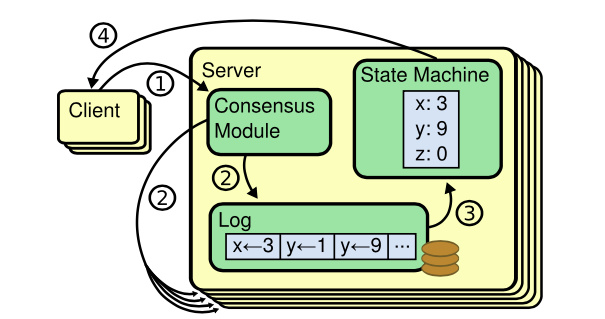
Figure 1: Replicated state machine architecture. The consensus algorithm manages a replicated log containing state machine commands from clients. The state machines process identical sequences of commands from the logs, so they produce the same outputs.
Replicated state machines are typically implemented using a replicated log, as shown in Figure 1. Keeping the replicated log consistent is the job of the consensus algorithm.
Consensus algorithms for practical systems typically have the following properties:
- They ensure safety (never returning an incorrect result) under all non-Byzantine conditions, including network delays, partitions, and packet loss, duplication, and reordering.
- They are fully functional (available) as long as any majority of the servers are operational and can communicate with each other and with clients. Thus a typical cluster of five servers can tolerate the failure of any two servers. Servers are assumed to fail by stopping; they may later recover from state on stable storage and rejoin the cluster.
- They do not depend on timing to ensure the consistency of the logs: faulty clocks and extreme message delays can, at worst, cause availability problems.
- In the common case, a command can complete as soon as a majority of the cluster has responded to a single round of remote procedure calls; a minority of slow servers need not impact overall system performance.
3. What’s wrong with Paxos? #
Paxos has two significant drawbacks.
- Paxos is exceptionally difficult to understand.
- Paxos does not provide a good foundation for building practical implementations.
4. Designing for understandability #
We had several goals in designing Raft: it must provide a complete and practical foundation for system building, so that it significantly reduces the amount of design work required of developers; it must be safe under all conditions and available under typical operating conditions; and it must be efficient for common operations. But our most important goal —— and most difficult challenge was understandability.
We used two techniques that are generally applicable.
- The first technique is the well-known approach of problem decomposition.
- The second approach was to simplify the state space by reducing the number of states to consider, making the system more coherent and eliminating nondeterminism where possible.
5. The Raft consensus algorithm #
Raft is an algorithm for managing a replicated log of the form described in Section 2.
Raft implements consensus by first electing a distinguished leader, then giving the leader complete responsibility for managing the replicated log. Given the leader approach, Raft decomposes the consensus problem into three relatively independent subproblems, which are discussed in the subsections that follow:
- Leader election: a new leader must be chosen when an existing leader fails (Section 5.2).
- Log replication: the leader must accept log entries from clients and replicate them across the cluster, forcing the other logs to agree with its own (Section 5.3).
- Safety: the key safety property for Raft is the State Machine Safety Property in Figure 3: if any server has applied a particular log entry to its state machine, then no other server may apply a different command for the same log index. Section 5.4 describes how Raft ensures this property; the solution involves an additional restriction on the election mechanism described in Section 5.2.

Figure 2: A condensed summary of the Raft consensus algorithm (excluding membership changes and log compaction). The server behavior in the upper-left box is described as a set of rules that trigger independently and repeatedly.

Figure 3: Raft guarantees that each of these properties is true at all times.
5.1 Raft basics #
A Raft cluster contains several servers (typical five servers). At any given time each server is in one of three states: leader, follower or candidate.
- Followers are passive: they issue no requests on their own but simply respond to requests from leaders and candidates.
- The leader handles all client requests (if a client contacts a follower, the follower redirects it to the leader).
- The candidate, is used to elect a new leader as described in Section 5.2.
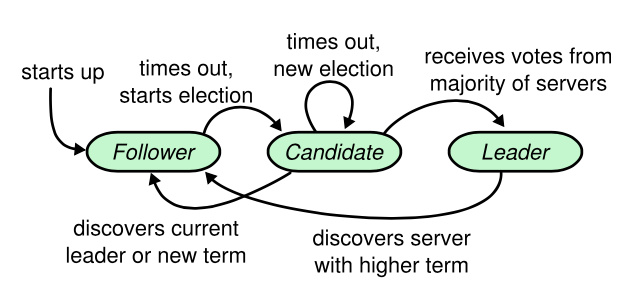
Figure 4: Server states. Followers only respond to requests from other servers. If a follower receives no communication, it becomes a candidate and initiates an election. A candidate that receives votes from a majority of the full cluster becomes the new leader. Leaders typically operate until they fail.
Raft divides time into terms of arbitrary length, as shown in Figure 5. Terms are numbered with consecutive integers. Each term begins with an election, in which one or more candidates attempt to become leader as described in Section 5.2. If a candidate wins the election, then it serves as leader for the rest of the term. In some situations an election will result in a split vote. In this case the term will end with no leader; a new term (with a new election) will begin shortly. Raft ensures that there is at most one leader in a given term.

Figure 5: Time is divided into terms, and each term begins with an election. After a successful election, a single leader manages the cluster until the end of the term. Some elections fail, in which case the term ends without choosing a leader. The transitions between terms may be observed at different times on different servers.
Terms act as a logical clock in Raft, and they allow servers to detect obsolete information such as stale leaders. Each server stores a current term number, which increases monotonically over time.
Raft servers communicate using remote procedure calls (RPCs), and the basic consensus algorithm requires only two types of RPCs.
- RequestVote RPCs are initiated by candidates during elections (Section 5.2).
- AppendEntries RPCs are initiated by leaders to replicate log entries and to provide a form of heartbeat(Section 5.3).
5.2 Leader election #
Raft uses a heartbeat mechanism to trigger leader election. When servers start up, they begin as followers. A server remains in follower state as long as it receives valid RPCs from a leader or candidate. Leaders send periodic heartbeats (AppendEntries RPCs that carry no log entries) to all followers in order to maintain their authority. If a follower receives no communication over a period of time called the election timeout, then it assumes there is no viable leader and begins an election to choose a new leader.
To begin an election, a follower increments its current term and transitions to candidate state. It then votes for itself and issues RequestVote RPCs in parallel to each of the other servers in the cluster. A candidate continues in this state until one of three things happens:
- It wins the election: it receives votes from a majority of the servers in the full cluster for the same term.
- Another server establishes itself as leader: it receives an AppendEntries RPC from another server claiming to be leader. If the leader’s term (included in its RPC) is at least as large as the candidate’s current term, then the candidate recognizes the leader as legitimate and returns to follower state.
- A period of time goes by with no winner: if many followers become candidates at the same time, votes could be split so that no candidate obtains a majority.
Raft uses randomized election timeouts to ensure that split votes are rare and that they are resolved quickly. To prevent split votes in the first place, election timeouts are chosen randomly from a fixed interval.
5.3 Log replication #
Once a leader has been elected, it begins servicing client requests. Each client request contains a command to be executed by the replicated state machines. The leader appends the command to its log as a new entry, then issues AppendEntries RPCs in parallel to each of the other servers to replicate the entry. When the entry has been safely replicated (as described below), the leader applies the entry to its state machine and returns the result of that execution to the client. If followers crash or run slowly, or if network packets are lost, the leader retries AppendEntries RPCs indefinitely (even after it has responded to the client) until all followers eventually store all log entries.
Logs are organized as shown in Figure 6. Each log entry stores a state machine command along with the term number when the entry was received by the leader. The term numbers in log entries are used to detect inconsistencies between logs and to ensure some of the properties in Figure 3. Each log entry also has an integer index identifying its position in the log.
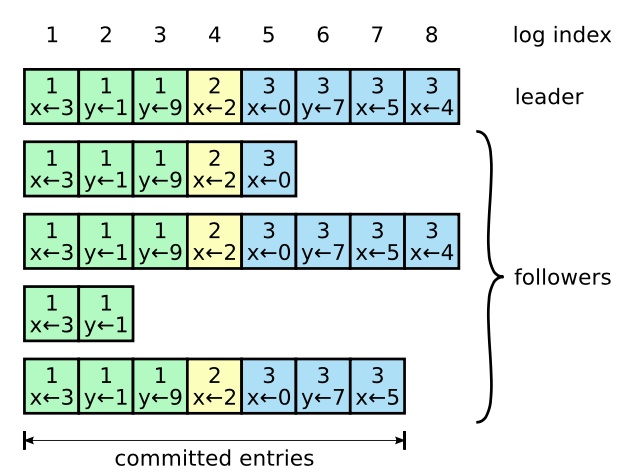
Figure 6: Logs are composed of entries, which are numbered sequentially. Each entry contains the term in which it was created ( the number in each box) and a command for the state machine. An entry is considered committed if it is safe for that entry to be applied to state machines.
The leader decides when it is safe to apply a log entry to the state machines; such an entry is called committed. A log entry is committed once the leader that created the entry has replicated it on a majority of the servers. (e.g., entry 7 in Figure 6). The leader keeps track of the highest index it knows to be committed, and it includes that index in future AppendEntries RPCs (including heartbeats) so that the other servers eventually find out. Once a follower learns that a log entry is committed, it applies the entry to its local state machine (in log order).
We designed the Raft log mechanism to maintain a high level of coherency between the logs on different servers. Raft maintains the following properties, which together constitute the Log Matching Property in Figure 3:
- If two entries in different logs have the same index and term, then they store the same command.
- If two entries in different logs have the same index and term, then the logs are identical in all preceding entries.
The first property follows from the fact that a leader creates at most one entry with a given log index in a given term. The second property is guaranteed by a simple consistency check performed by AppendEntries. When sending an AppendEntries RPC, the leader includes the index and term of the entry in its log that immediately precedes the new entries. If the follower does not find an entry in its log with the same index and term, then it refuses the new entries. As a result, whenever AppendEntries returns successfully, the leader knows that the follower’s log is identical to its own log up through the new entries.
During normal operation, the logs of the leader and followers stay consistent, so the AppendEntries consistency check never fails. However, leader crashes can leave the logs inconsistent. Figure 7 illustrates the ways in which followers' logs may differ from that of a new leader.
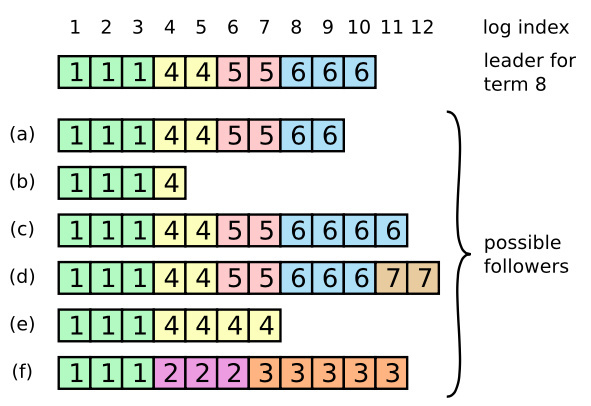
Figure 7: When the leader at the top comes to power, it is possible that any of scenarios (a-f) could occur in follower logs. Each box represents one log entry; the number in the box is its term. A follower may be missing entries (a-b), may have extra uncommitted entries (c-d), or both (e-f). For example, scenario (f) could occur if that server was the leader for term 2, added several entries to its log, then crashed before committing any of them; it restarted quickly, became leader for term3, and added a few more entries to its log; before any of the entries in either term2 or term3 were committed, the server crashed again and remained down for several terms.
In Raft, the leader handles inconsistencies by forcing the followers' logs to duplicate its own.
To bring a follower’s log into consistency with its own, the leader must find the latest log entry where the two logs agree, delete any entries in the follower’s log after that point, and send the follower all of the leader’s entries after that point. All of these actions happen in response to the consistency check performed by AppendEntries RPCs. The leader maintains a nextIndex for each follower, which is the index of the next log entry the leader will send to that follower. When a leader first comes to power, it initializes all nextIndex values to the index just after the last one in its log (11 in Figure 7). If a follower’s log is inconsistent with the leader’s, the AppendEntries consistency check will fail in the next AppendEntries RPC. After a rejection, the leader decrements nextIndex and retries the AppendEntries RPC. Eventually nextIndex will reach a point where the leader and follower logs match.
With this mechanism, a leader does not need to take any special actions to restore log consistency when it comes to power. It just begins normal operation, and the logs automatically converge in response to failures of the AppendEntries consistency check. A leader never overwrites or deletes entries in its own log (the Leader Append-Only Property in Figure 3).
This log replication mechanism exhibits the desirable consensus properties described in Section 2: Raft can accept, replicate, and apply new log entries as long as a majority of the servers are up; in the normal case a new entry can be replicated with a single round of RPCs to a majority of the cluster; and a single slow follower will not impact performance.
5.4 Safety #
The mechanisms described so far are not quite sufficient to ensure that each state machine executes exactly the same commands in the same order. For example, a follower might be unavailable while the leader commits several log entries, then it could be elected leader and overwrite these entries with new ones; as a result, different state machines might execute different command sequences.
This section completes the Raft algorithm by adding a restriction on which servers may be elected leader. The restriction ensures that the leader for any given term contains all of the entries committed in previous terms (the Leader Completeness Property from Figure 3).
5.4.1 Election restriction #
In any leader-based consensus algorithm, the leader must eventually store all of the committed log entries. Raft uses a simpler approach where it guarantees that all the committed entries from previous terms are present on each new leader from the moment of its election, without the need to transfer those entries to the leader. This means that log entries only flow in one direction, from leaders to followers , and leaders never overwrite existing entries in their logs.
Raft uses the voting process to prevent a candidate from winning an election unless its log contains all committed entries. The RequestVote RPC implements this restriction: the RPC includes information about the candidate’s log, and the voter denies its vote if its own log is more up-to-date than that of the candidate.
Raft determines which of two logs is more up-to-date by comparing the index and term of the last entries in the logs. If the logs have last entries with different terms, then the log with the later term is more up-to-date. If the logs end with the same term, then whichever logs is longer is more up-to-date.
5.4.2 Committing entries from previous terms #
As described in Section 5.3, a leader knows that an entry from its current term is committed once that entry is stored on a majority of the servers. If a leader crashes before committing an entry, future leaders will attempt to finish replicating the entry. However, a leader cannot immediately conclude that an entry from a previous term is committed once it is stored on a majority of servers. Figure 8 illustrates a situation where an old log entry is stored on a majority of servers, yet can still be overwritten by a future leader.
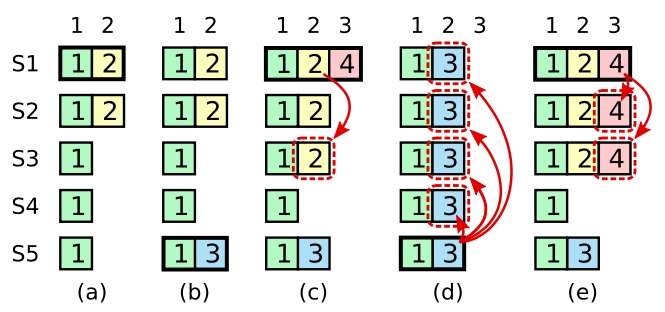
Figure 8: A time sequence showing why a leader cannot determine commitment using log entries from older terms. In (a) S1 is leader and partially replicates the log entry at index 2. In (b) S1 crashes; S5 is elected leader from term3 with votes from S3, S4, and itself, and accepts a different entry at log index 2. In (c) S5 crashes; S1 restarts, is elected leader, and continues replication. At this point, the log entry from term 2 has been replicated on a majority of the servers, but it is not committed. If S1 crashes as in (d), S5 could be elected leader (with votes from S2, S3, and S4) and overwrite the entry with its own entry from term 3. However, if S1 replicates an entry from its current term on a majority of the servers before crashing, as in (e), then this entry is committed (S5 cannot win an election). At this point all preceding entries in the log are committed as well.
To eliminate problems like the one in Figure 8, Raft never commits log entries from previous terms by counting replicas. Only log entries from the leader’s current term are committed by counting replicas; once an entry from the current term has been committed in this way, then all prior entries are committed indirectly because of the Log Matching Property. There are some situations where a leader could safely conclude that an older log entry is committed (for example, if that entry is stored on every server), but Raft takes a more conservative approach from simplicity.
Raft incurs this extra complexity in the commitment rules because log entries retain their original term numbers when a leader replicates entries from previous terms.
5.4.3 Safety argument #
Given the complete Raft algorithm, we can now argue more precisely that the Leader Completeness Property holds (this argument is based on the safety proof; see Section 9.2). We assume that the Leader Completeness Property does not hold, then we prove a contradiction. Suppose the leader for term T (leaderT) commits a log entry from its term, but that log entry is not stored by the leader of some future term. Consider the smallest term U (U > T) whose leader (leaderU) does not store the entry.
-
The committed entry must have been absent from leaderU’s log at the time of its election (leaders never delete or overwrite entries).
-
leaderT replicated the entry on a majority of the cluster, and leaderU received votes from a majority of the cluster. Thus, at least one server (“the voter”) both accepted the entry from leaderT and voted for leaderU, as shown in Figure 9. The voter is key to reaching a contradiction.
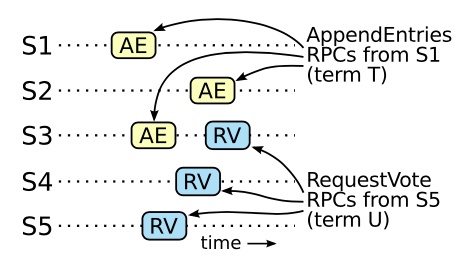
Figure 9: If S1 (leader from term T) commits a new log entry from its term, and S5 is elected leader from a later term U, then there must be at least one server (S3) that accepted the log entry and also voted for S5.
-
The voter must have accepted the committed entry from leaderT before voting for leaderU; otherwise it would have rejected the AppendEntries request from leaderT (its current term would have been higher than T).
-
The voter still stored the entry when it voted for leaderU, since every intervening leader contained the entry (by assumption), leaders never remove entries, and followers only remove entries if they conflict with the leader.
-
The voter granted its vote to leaderU, so leaderU’s log must have been as up-to-date as the voter’s. This leads to one of two contradictions.
-
First, if the voter and leaderU shared the same last log term, then leaderU’s log must have been at least as long as the voter’s, so its log contained every entry in the voter’s log. This is a contradiction, since the voter contained the committed entry and leaderU was assumed not to.
-
Otherwise, leaderU’s last log term must have been larger than the voter’s. Moreover, it was larger than T, since the voter’s last log term was as leader T (it contains the committed entry from term T). The earlier leader that created leaderU’s last log entry must have contained the committed entry in its log (by assumption). Then, by the Log Matching Property, leaderU’s log must also contain the committed entry, which is a contradiction.
-
This completes the contradiction. Thus, the leaders of all terms greater than T must contain all entries from term T that are committed in term T.
-
The Log Matching Property guarantees that future leaders will also contain entries that are committed indirectly, such as index 2 in Figure 8(e).
Given the Leader Completeness Property, we can prove the State Machine Safety Property from Figure 3, which states that if a server has applied a log entry at a given index to its state machine, no other server will ever apply a different log entry for the same index. At the time a server applies a log entry to its state machine, its log must be identical to the leader’s log up through that entry and the entry must be committed. Now consider the lowest term in which any server applies a given log index; the Log Completeness Property guarantees that the leaders for all higher terms will store that same log entry, so servers that apply the index in later terms will apply the same value. Thus the State Machine Safety Property holds.
Finally, Raft requires servers to apply entries in log index order. Combined with the State Machine Safety Property, this means that all servers will apply exactly the same set of log entries to their state machines, in the same order.
5.5 Follower and candidate crashes #
If a follower or candidate crashes, then future RequestVote and AppendEntries RPCs sent to it will fail. Raft handles these failures by retrying indefinitely; if the crashed server restarts, then the RPC will complete successfully. If a server crashes after completing an RPC but before responding, then it will receive the same RPC again after it restarts. Raft RPCs are idempotent, so this causes no harm.
5.6 Timing and availability #
One of our requirements for Raft is that safety must not depend on timing: the system must not produce incorrect results just because some event happens more quickly or slowly than expected. However, availability (the ability of the system to respond to clients in a timely manner) must inevitably depend on timing.
Leader election is the aspect of Raft where timing is most critical. Raft will be able to elect and maintain a steady leader as long as the system satisfies the following timing requirement:
**broadcast Time « election Timeout « MTBF (the average time between failures for a single server) **